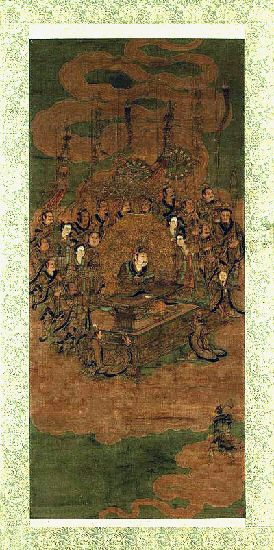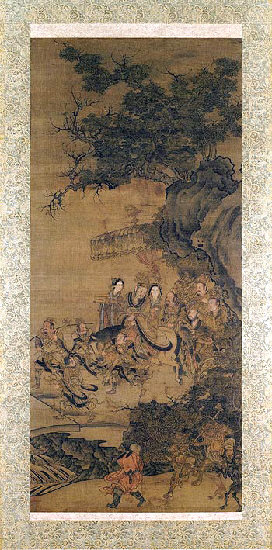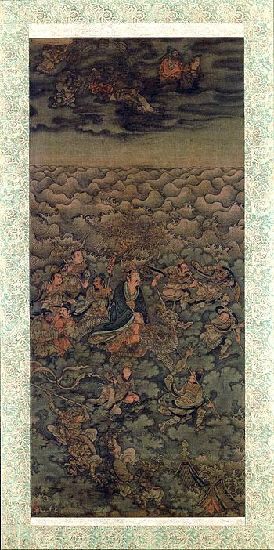This painting shows the Official of Heaven at his desk in the heavens,
surrounded by a group of officers and female attendants, called "jade
maidens." In front of his desk kneels a Taoist priest, suggesting that this
painting was originally made for a ritual in which the priest would envision
himself in a similar audience. A lesser officer of the Official of Heaven rises
from the lower right, probably intending to either report on the human world
or deliver an official petition. The dynamic movement of the clouds upon which these figures hover and the
remarkable detail of this and the other paintings from the triptych make them
among the most important Taoist paintings to have survived from the Southern
Song dynasty. |
This shows the Official of Earth traveling through a mountainous
landscape, about to cross a bridge. It was the duty of the Three Officials to
travel through the world observing and recording the good and bad deeds of
people and then to punish them appropriately. The Official of Earth is shown here on such an inspection tour. He is
accompanied by martial figures appropriate to the severity of his office and
demons responsible for punishing wrongdoers. Of particular interest is the tree
spirit, a small dark figure with barklike skin in the lower right corner of the
painting. Watching over the demons, in the bottom center of the painting, is
Zhong Kui, the "Demon Queller"—a fierce popular figure who was believed to
have taken a vow to protect people from unfair demon attacks. His presence is
most necessary here, since demons were known to be overly enthusiastic in
their punishments, often indiscriminately harming innocent and guilty alike.
This is one of the earliest known depictions of Zhong Kui, who would become
a popular figure in later Chinese art. |
Here, the Official of Water travels through the rough waves of a
churning ocean. He rides on a dragon, a traditional symbol of rain, while two
attendants ride on sea turtles. Because of their unusual longevity, these turtles
represented long life and divinity. The Official of Water is further accompanied
by several energetic figures, many of whom are wearing armor and carrying
weapons. These details emphasize the god's role as a judge, surrounded by
those who can enforce his will. In the bottom right of the painting, the roofs
of submerged palace buildings can be seen. These may represent either the
palace of the underwater Dragon King or the dwelling of the Official of Water
himself. In the sky above the ocean is the Duke of Thunder, a winged,
animal-headed god surrounded by a circle of giant drums, which his servants
strike to create thunder.
The dark, wet ink used to paint the clouds around the Duke of Thunder, paired
with the vigorous movement of the waves, suggest that the sky and ocean are
about to burst into a violent storm. This concern for atmosphere is
characteristic of the best Song-dynasty landscape painting. |


